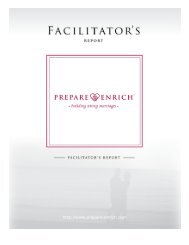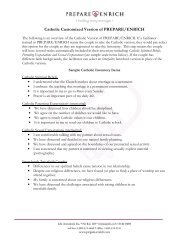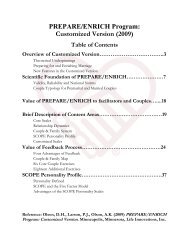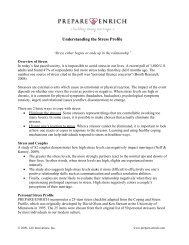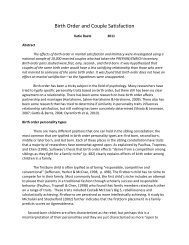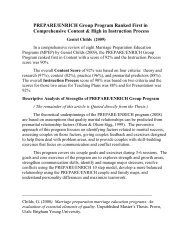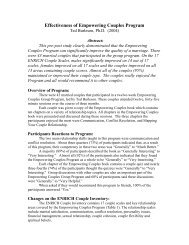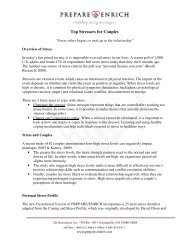PREPARE/ENRICH Customized Version
PREPARE/ENRICH Customized Version
PREPARE/ENRICH Customized Version
You also want an ePaper? Increase the reach of your titles
YUMPU automatically turns print PDFs into web optimized ePapers that Google loves.
http://www.prepare-enrich.com
<strong>PREPARE</strong>/<strong>ENRICH</strong><br />
<strong>Customized</strong> <strong>Version</strong><br />
Congratulations on completing the <strong>PREPARE</strong>/<strong>ENRICH</strong> inventory. Taking the time to reflect on your<br />
relationship is an important part of growing as a couple. Based on over 30 years of research, the<br />
questions and topics addressed by your assessment were customized to your relationship. These<br />
results are summarized in the following report pages.<br />
<strong>PREPARE</strong>/<strong>ENRICH</strong> is designed to get you thinking and talking about your relationship. This report<br />
can help identify your relationship strengths, which are resources you can use to build your<br />
relationship. Your results will also highlight growth areas that need to be improved. All<br />
relationships require attention, maintenance, and direction to keep growing and running<br />
smoothly. Don't view your results as permanent or unchangeable. These results are a snapshot<br />
of how you each described your relationship on the day you took the assessment.<br />
Your trained <strong>PREPARE</strong>/<strong>ENRICH</strong> facilitator will be able to provide you with feedback and answer<br />
questions as you go through the results together. They are also trained to teach you new<br />
relationship skills that can lead to a more satisfying couple relationship.<br />
We encourage you to consider taking an anniversary Couple Checkup each year at the website,<br />
http://www.couplecheckup.com as a way to proactively enrich your relationship. Remember, the<br />
more you invest in your relationship, the more you will both benefit: We wish you much success<br />
in growing together as a couple!<br />
Contents<br />
Report Section Page<br />
Couple Typology / Strength & Growth Areas 3<br />
Relationship Dynamics 4<br />
Personal Stress Profile 5<br />
Couple Map 6<br />
Family Map 7<br />
SCOPE Personality Scales 8-10<br />
<strong>PREPARE</strong>/<strong>ENRICH</strong><br />
© Copyright, 2008 - 2013<br />
Life Innovations, Inc.<br />
2
Couple Typology (Core Scales)<br />
Conventional Couple Type<br />
Based on the PCA scores across the core categories, this couple is best categorized as a Conventional Couple.<br />
Conventional couples are often highly committed and have more strengths in areas such as Relationship Roles and<br />
Spiritual Beliefs. They can improve the quality of their relationship by working on communication and conflict<br />
resolution skills.<br />
Based on past research with thousands of couples, <strong>PREPARE</strong>/<strong>ENRICH</strong> categorizes couple relationships into one of five common<br />
relational patterns:<br />
Vitalized couples are typically most satisfied with their relationship, skilled in communication and conflict resolution.<br />
Harmonious couples also enjoy high levels of satisfaction across most areas of their relationship.<br />
Conventional couples are often highly committed to one another, but not as skilled in communication or conflict resolution.<br />
Conflicted couples have a lower level of satisfaction and often struggle with many areas of their relationship.<br />
Devitalized couples have the lowest level of satisfaction and have growth areas in almost all aspects of their relationship.<br />
Strength and Growth Areas<br />
Levels of Positive Couple Agreement<br />
Relationship Strengths (PCA=80 - 100%)<br />
Areas with High Couple Agreement<br />
Possible Relationship Strengths (PCA=50 - 70%)<br />
Areas with Moderately High Couple Agreement<br />
Possible Growth Areas (PCA=30 - 40%)<br />
Areas with Moderately Low Couple Agreement<br />
Growth Areas (PCA=0 - 20%)<br />
Areas with Low Couple Agreement<br />
Core and <strong>Customized</strong> Scales<br />
Cultural/Ethnic Issues<br />
Family & Friends<br />
Financial Management<br />
Spiritual Beliefs<br />
Conflict Resolution<br />
Sexual Relationship<br />
Communication<br />
Forgiveness<br />
Roles & Responsibilities<br />
Step Parenting Issues<br />
Leisure Activities<br />
Partner Style & Habits<br />
3
Relationship Dynamics<br />
Assertiveness is the ability to express one's feelings and ask for what one wants.<br />
Prentiss:<br />
Very High<br />
Prentiss is good at openly expressing thoughts and feelings, and can easily ask for what he/she wants<br />
in the relationship.<br />
Jana:<br />
Average<br />
Jana is generally good at expressing thoughts and feelings, and is sometimes able to ask for what<br />
he/she wants in the relationship.<br />
Self Confidence focuses on how good one feels about oneself and their ability to accomplish what they want<br />
in life.<br />
Prentiss:<br />
Very High<br />
Prentiss has a very high level of Self Confidence, positive self-esteem, and feels very sure of his/her<br />
ability to effectively accomplish what is wanted in life.<br />
Jana:<br />
Average<br />
Jana has a moderate level of Self Confidence and may generally have positive self-esteem, and<br />
typically feels good about his/her ability to accomplish what is wanted in life.<br />
Avoidance is the tendency to minimize issues and reluctance to deal with issues directly.<br />
Both:<br />
Very Low<br />
Both individuals scored very low in Avoidance and will often be open to identifying and discussing<br />
issues in their relationship.<br />
Partner Dominance focuses on how much one feels controlled or dominated by their partner.<br />
Prentiss:<br />
Low<br />
Prentiss scored in the low range in Partner Dominance and seldom feels his/her partner is dominant,<br />
controlling, or interested in managing his/her life.<br />
Jana:<br />
High<br />
Jana scored in the high range in Partner Dominance and may often feel his/her partner is dominant,<br />
controlling, or interested in managing his/her life.<br />
4
Personal Stress Profile<br />
The Personal Stress Profile examines each individual's personal stress level over the last year. Stress levels<br />
are based on responses to 25 common sources of personal stress.<br />
Prentiss appears to have a low level of frustration or<br />
personal stress. While stress may create some<br />
demands on time, patience, and energy, it appears to<br />
be at a manageable level. It may still be helpful to<br />
identify and understand effective coping resources<br />
for stress.<br />
Jana appears to have a high level of personal stress<br />
which can create many demands on a person’s time<br />
and energy. The stress may also contribute to<br />
problems with physical, relational, and emotional<br />
health. It will be helpful to learn and make use of<br />
effective coping resources to better manage personal<br />
stress.<br />
Never<br />
1<br />
How often have these issues created stress for you?<br />
Seldom<br />
Sometimes<br />
Often<br />
2<br />
3<br />
4<br />
Very Often<br />
5<br />
Prentiss<br />
Top 10 Stressors<br />
Often<br />
Poor health of other family members<br />
Your child/children<br />
Your own health<br />
Sometimes<br />
Lack of sleep<br />
Lack of time for family<br />
Lack of time for yourself<br />
Time away from family<br />
Your job<br />
Your spouse<br />
Jana<br />
Top 10 Stressors<br />
Very Often<br />
Your child/children<br />
Often<br />
Lack of exercise<br />
Lack of time for family<br />
Your current housing arrangement<br />
Your spouse<br />
Sometimes<br />
Eating too much<br />
Feeling emotionally upset<br />
Feeling overweight<br />
Feeling physically ill<br />
Lack of sleep<br />
Help this couple compare their lists of top stressors. It is not uncommon for their lists to be somewhat<br />
different. Take a moment to help them discuss where things are similar and where they are different. Key<br />
resources for coping with stress include healthy communication, conflict resolution, flexibility, and closeness.<br />
<strong>PREPARE</strong>/<strong>ENRICH</strong> Exercises: Identifying Most Critical Issues, Balancing your Priorities<br />
5
Couple Map<br />
OVERLY<br />
FLEXIBLE<br />
VERY<br />
FLEXIBLE<br />
FLEXIBLE JANA<br />
SOMEWHAT<br />
FLEXIBLE<br />
PRENTISS<br />
INFLEXIBLE<br />
DIS-<br />
CONNECTED<br />
SOMEWHAT<br />
CONNECTED<br />
CONNECTED<br />
VERY<br />
CONNECTED<br />
OVERLY<br />
CONNECTED<br />
Couple Closeness is defined as the emotional closeness one feels toward their partner. On this dimension,<br />
relationships can range from disconnected to overly connected.<br />
Prentiss describes this relationship as Very Connected. Very connected couples often have a good balance<br />
of closeness and separateness, which reflects an interdependent relationship. Healthy marriages foster<br />
connection, but also leave room for each partner to pursue individual interests and activities.<br />
Jana describes this relationship as Somewhat Connected. These individuals often feel somewhat<br />
disconnected or emotionally distant from their partner. Less connected partners are often more independent<br />
from one another. They need to guard against allowing their relationship to get too disconnected.<br />
Couple Flexibility is defined as the ability to adjust to changes in roles and leadership in response to life's<br />
demands. On this dimension, relationships can range from inflexible to overly flexible.<br />
Prentiss feels the relationship is Somewhat Flexible, with more stability and less openness to change. They<br />
may sometimes resist changes in leadership or roles and may need to remember that healthy relationships<br />
often require the ability to be flexible while meeting the demands of busy lives.<br />
Jana feels the relationship is Flexible. Relationships in the flexible range are open to change when necessary,<br />
with a good balance between stability and change. Leadership and decision-making are equally shared, and<br />
roles can adjust to life's demands. This is a healthy balance that most couples enjoy.<br />
Couple Discussion: Review the closeness and flexibility results. It can be helpful to discuss what is positive<br />
about the current levels of closeness and flexibility. It can also be helpful to discuss any desired changes<br />
(increases or decreases) in closeness and flexibility.<br />
<strong>PREPARE</strong>/<strong>ENRICH</strong> Exercises: Mapping Your Relationship, Closeness Exercises, Flexibility Exercises<br />
6
Family Map<br />
OVERLY<br />
FLEXIBLE<br />
VERY<br />
FLEXIBLE<br />
JANA PRENTISS<br />
FLEXIBLE<br />
SOMEWHAT<br />
FLEXIBLE<br />
INFLEXIBLE<br />
DIS-<br />
CONNECTED<br />
SOMEWHAT<br />
CONNECTED<br />
CONNECTED<br />
VERY<br />
CONNECTED<br />
OVERLY<br />
CONNECTED<br />
Family Closeness is defined as the emotional closeness one felt growing up in their family of origin. On this<br />
dimension, family relationships can range from disconnected to overly connected.<br />
Prentiss grew up in a Very Connected family. Individuals in this type of family likely felt very close to one<br />
another. Most healthy families are connected and enjoy being together, yet permit some independence of<br />
their family members.<br />
Jana grew up in a Connected family. Individuals in these families generally feel close to one another and<br />
have a good balance of closeness and separateness.<br />
Family Flexibility is defined as a family's ability to adjust to changes in roles, leadership and discipline. On<br />
this dimension, family relationships can range from inflexible to overly flexible.<br />
Both individuals experienced families of origin that felt Very Flexible. These families are generally open to<br />
change and somewhat loosely organized. Leadership and decision-making are shared, and roles and routines<br />
are adjusted as needed.<br />
Couple Discussion: review family of origin closeness and flexibility results. Discuss family closeness and<br />
flexibility with actual examples such as observing a holiday, celebrating a birthday, or handling discipline.<br />
What does each person want to bring from their family into the current relationship? What does each person<br />
want to leave behind?<br />
<strong>PREPARE</strong>/<strong>ENRICH</strong> Exercises: Mapping Your Relationship, Closeness Exercises, Flexibility Exercises<br />
7
SCOPE Personality Scales<br />
The SCOPE Personality assessment consists of five dimensions based on the Five Factor Model of Personality.<br />
The five dimensions and the couple's results are described below. Review the results of all five dimensions<br />
rather than focusing on just one or two traits where individuals score high or low.<br />
Compare where the Personality SCOPE results are similar and where they are different. Discuss the advantages<br />
and drawbacks to each.<br />
<strong>PREPARE</strong>/<strong>ENRICH</strong> Exercises: SCOPE out Your Personality<br />
Social (S)<br />
This trait reflects preference for, and behavior in social situations.<br />
Prentiss scored High on the Social dimension. These individuals are generally outgoing. Social extroverts enjoy<br />
being with people and are often full of energy. They may be enthusiastic and action-oriented. They often enjoy<br />
their ability to make friends and acquaintances easily and do not prefer solitude. In groups they like to talk,<br />
assert themselves, and may often be the center of attention. If out of balance, they could appear to be<br />
attention seeking or shallow.<br />
Jana scored Low on being Social. These individuals tend to be reserved or introverted. Social introverts often<br />
lack the exuberance and activity levels of extroverts. They may be low-key, deliberate, and less connected<br />
socially. They often prefer to be alone or with just a few close friends. These individuals likely feel re-energized<br />
after spending time alone or in small, intimate settings, as opposed to large groups or parties. If out of balance,<br />
they could appear reclusive or cut off from others.<br />
Couple Discussion:<br />
Couples with one person scoring higher than the other will need to communicate openly with one another about<br />
attending social events and getting together with others. One person receives energy from socializing with<br />
others, while the other prefers more privacy and alone time. This difference may become more apparent when<br />
they are experiencing greater amounts of stress. They can avoid unnecessary conflict in their relationship by<br />
checking it out with each other before saying "yes" or "no" to making social plans.<br />
8
SCOPE Personality Scales<br />
Change (C)<br />
This trait reflects openness to change, flexibility, and interest in new experiences.<br />
Prentiss scored High on Change. These individuals will tend to be flexible, unconventional, and very open to<br />
new experiences. They are open to change, and often have a broad range of interests. They thrive on<br />
developing new and creative solutions to problems, even when a tried and true method might work just as well.<br />
When out of balance, they may appear to be too interested in new ideas and adventures. Others may wonder<br />
why they are constantly trying to reinvent the wheel.<br />
Jana scored Low on Change. These individuals are more down to earth, practical in nature, and less interested<br />
in new ideas and experiences. Change may be difficult for them and increase their level of stress. These<br />
individuals prefer the familiar and things they are accustomed to. Their attitudes are likely to be more<br />
conventional or traditional. When out of balance, they could appear rigid or closed off to new experiences.<br />
Couple Discussion:<br />
One person scoring higher than the other may represent a case of being attracted to their opposite. The more<br />
practical person is often attracted to the other's free thinking and open attitudes. Conversely, the more open<br />
person may recognize the value of their partner's steady approach to life. There may be times when the other's<br />
attitudes, preferences or behavior will be challenging or frustrating. They'll want to remember to work with<br />
differences rather than attempt to change or criticize one another. Building off each other’s strengths can help<br />
them appreciate their differences.<br />
Organized (O)<br />
This trait reflects how organized and persistent a person is in their daily life and work.<br />
It also reflects persistence in pursuing goals.<br />
Prentiss scored in the High range on this personality dimension. These individuals are methodical, and wellorganized.<br />
They tend to be persistent and reliable and place great emphasis on this type of behavior. They are<br />
quite goal-oriented, and have a well thought-out plan as they strive to achieve their goals. When out of balance,<br />
they could be perceived as a perfectionist or too driven. Others may even see them as being too organized or<br />
controlling in their approach to life.<br />
Jana scored in the Average range on this personality dimension. These individuals are generally organized.<br />
They are often dependable and goal-oriented, but can also be flexible, setting aside work and agendas. They<br />
know how to get organized, but it is not always a high priority. Their home and workspace are likely somewhat<br />
cluttered, but they know where things are located.<br />
Couple Discussion:<br />
Couples with one person scoring higher than the other will need to communicate openly with one another about<br />
their goals, roles, and expectations. It is likely that their partner’s tendencies may be endearing at times, but can<br />
also become annoying, distracting, or even maddening when stressful events come their way. They can balance<br />
one another out and avoid the extremes of perfectionism versus sloppiness. Potential challenges include<br />
different expectations for housekeeping, relationship roles, and long-term goals. They can work with their<br />
strengths and allow the more organized individual to handle necessary details. But they will also need to guard<br />
against expecting the organized individual to function more like a "parent" and less like a “partner.”<br />
9
SCOPE Personality Scales<br />
Pleasing (P)<br />
This trait reflects how considerate and cooperative one is in their interactions with<br />
others.<br />
Prentiss scored in the Average range on Pleasing. These individuals can be warm and cooperative, but<br />
occasionally somewhat competitive, stubborn, or assertive. When they feel their rights are violated, they are<br />
able to respond and stand up for themselves. They might occasionally find themselves arguing about little<br />
matters, but generally know how to get along well with others and are well liked.<br />
Jana scored Low on Pleasing. These individuals tend to be very assertive and less cooperative. They may<br />
express their anger directly, and could be seen as competitive and proud. They may experience high levels of<br />
conflict in their partner relationship unless they have learned how to balance their assertiveness. These<br />
individuals are less likely to be taken advantage of and can stand up for themselves. When out of balance, they<br />
could appear skeptical, unfriendly, or even controlling. They may sometimes find that others are intimidated by<br />
their direct approach.<br />
Couple Discussion:<br />
Couples with one person scoring higher than the other may need to practice their communication and conflict<br />
resolution skills. One partner may need to develop their ability to honestly express both positive and negative<br />
opinions and feelings. In so doing, they can allow the more assertive partner the opportunity to truly understand<br />
how they feel. The other partner will benefit from working to be a good listener. Looking for the positives in each<br />
other's personality styles can strengthen the relationship.<br />
Emotionally Steady (E)<br />
This trait reflects the tendency to stay relaxed and calm even when faced with stress,<br />
versus those who are more reactive to stress in their life.<br />
Prentiss scored High in the Emotionally Steady trait. These individuals tend to be more relaxed, calm and less<br />
prone to distress. They are likely to be emotionally stable even when confronted with stressful situations. At<br />
times, they can even appear unfeeling or unflappable. They often consider life’s stressors to be minor passing<br />
annoyances and have an ability to remain composed in situations that others find difficult.<br />
Jana scored Low on Emotionally Steady. These individuals are more emotionally sensitive and may be easily<br />
upset. They have more difficulty handling stress in their life. They often don't enjoy new situations, and may<br />
tend to avoid such experiences. They may be prone to anxiety, anger or depression when faced with stressful<br />
situations. When out of balance, these individuals appear fragile or overly sensitive. Some acquaintances may<br />
see their reactions as difficult to handle and pull away leaving them to feel even more isolated.<br />
Couple Discussion:<br />
Couples with one person scoring higher than the other may experience occasional challenges. In times of stress,<br />
the more emotionally calm person may need to take control and help the other feel less frustrated. The one<br />
experiencing anxiety, anger or sadness might wonder why their partner doesn't feel the same way. They will<br />
need to remember to work with one another's differences rather than attempting to change each other.<br />
Flexibility, problem solving and communication are key skills to help them deal with stress as a couple.<br />
10




